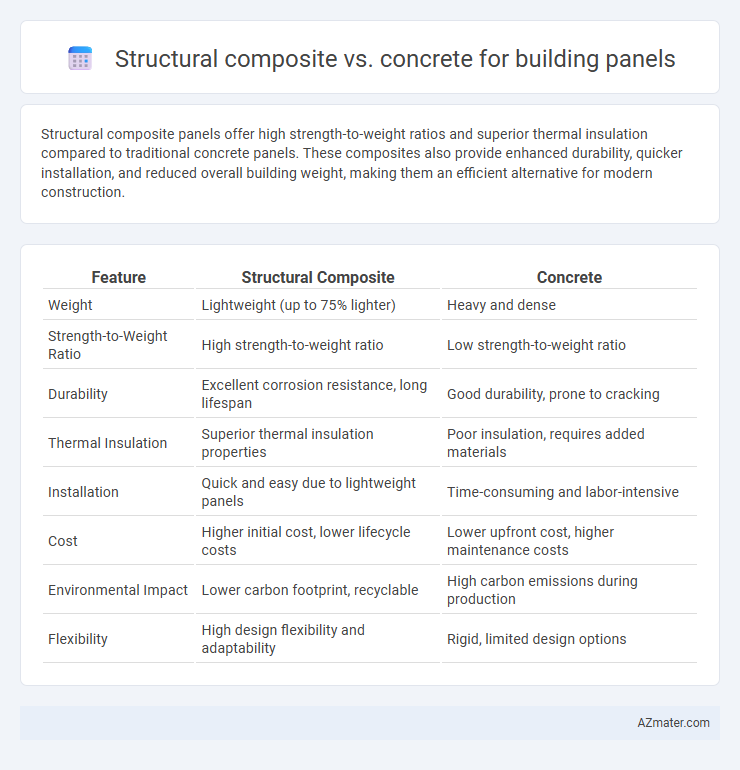Structural composite panels offer high strength-to-weight ratios and superior thermal insulation compared to traditional concrete panels. These composites also provide enhanced durability, quicker installation, and reduced overall building weight, making them an efficient alternative for modern construction.
Table of Comparison
| Feature | Structural Composite | Concrete |
|---|---|---|
| Weight | Lightweight (up to 75% lighter) | Heavy and dense |
| Strength-to-Weight Ratio | High strength-to-weight ratio | Low strength-to-weight ratio |
| Durability | Excellent corrosion resistance, long lifespan | Good durability, prone to cracking |
| Thermal Insulation | Superior thermal insulation properties | Poor insulation, requires added materials |
| Installation | Quick and easy due to lightweight panels | Time-consuming and labor-intensive |
| Cost | Higher initial cost, lower lifecycle costs | Lower upfront cost, higher maintenance costs |
| Environmental Impact | Lower carbon footprint, recyclable | High carbon emissions during production |
| Flexibility | High design flexibility and adaptability | Rigid, limited design options |
Introduction to Building Panel Materials
Structural composites offer lightweight strength and enhanced durability compared to traditional concrete panels, making them ideal for modern construction projects seeking energy efficiency and faster installation. Concrete panels provide excellent fire resistance, thermal mass, and sound insulation, commonly used in load-bearing applications requiring long-term stability. Innovations in both materials continue to improve performance, with composites integrating fibers and resins for tailored mechanical properties and concrete mixtures optimized for strength and sustainability.
Overview of Structural Composites
Structural composites in building panels combine materials such as fiberglass, carbon fiber, or natural fibers with resins to create lightweight, high-strength solutions with excellent thermal insulation and corrosion resistance. These composites offer superior flexural strength and impact resistance compared to traditional concrete, enabling faster installation and design flexibility for complex architectural forms. The anisotropic properties of structural composites can be engineered to optimize performance, reducing overall building weight and improving energy efficiency.
Understanding Concrete Panels
Concrete panels offer superior thermal mass and fire resistance, making them ideal for energy-efficient and durable building envelopes. Unlike structural composites, which rely on layered materials like fibers and resins, concrete panels provide uniform strength and excellent sound insulation due to their dense composition. Their ability to be precast into various shapes enhances design flexibility while reducing on-site construction time and labor costs.
Key Material Properties Comparison
Structural composite panels offer superior strength-to-weight ratios compared to concrete panels, enabling easier handling and faster installation. Concrete panels excel in compressive strength and fire resistance, making them ideal for load-bearing and fire-rated applications. While composites provide enhanced flexibility and impact resistance, concrete ensures durability against environmental degradation and thermal mass benefits.
Load-Bearing Capacity: Composites vs Concrete
Structural composites exhibit higher strength-to-weight ratios compared to traditional concrete, enabling superior load-bearing capacity with reduced self-weight. Advanced composites such as carbon fiber-reinforced polymers (CFRP) provide enhanced tensile strength and flexural performance, outperforming concrete panels especially in seismic and dynamic load scenarios. Concrete panels excel in compressive strength but are heavier, potentially increasing foundation load and requiring thicker support structures, whereas composites allow for thinner, lighter panels with comparable or greater load-bearing efficiency.
Thermal and Acoustic Performance
Structural composite panels exhibit superior thermal insulation due to integrated layers of materials like foam cores and fiber reinforcements, which reduce heat transfer more effectively than traditional concrete panels. For acoustic performance, composites absorb and dampen sound waves better, minimizing noise transmission through building envelopes, whereas concrete's density provides mass-based sound insulation but less absorption. Selecting structural composites enhances energy efficiency and occupant comfort by optimizing both thermal resistance and sound attenuation compared to standard concrete panels.
Durability and Weather Resistance
Structural composite panels offer superior durability and weather resistance compared to traditional concrete panels, as they resist moisture infiltration, corrosion, and freeze-thaw cycles more effectively. Engineered with materials such as fiberglass, resin, and wood fibers, composite panels maintain structural integrity in harsh environmental conditions, reducing maintenance costs over time. Concrete panels, while strong in compressive strength, are more susceptible to cracking, spalling, and water damage, which can compromise longevity and necessitate frequent repairs in severe weather climates.
Installation and Construction Efficiency
Structural composite panels offer a significant advantage in installation speed and construction efficiency compared to traditional concrete panels due to their lightweight nature and prefab compatibility, reducing labor costs and construction time on-site. The ease of handling and cutting composite panels allows for quicker adjustments and installation, while concrete panels often require longer curing times and heavy machinery for positioning. These factors make structural composites increasingly preferred in projects aiming for rapid build cycles and reduced logistical complexity.
Cost Considerations
Structural composite panels generally offer lower installation costs due to their lighter weight and ease of handling compared to traditional concrete panels, which require heavy machinery and longer curing times. Concrete panels incur higher material costs and labor expenses, influenced by formwork, reinforcement, and extended onsite curing processes. Long-term maintenance for structural composites is often more economical due to resistance to corrosion and cracking, while concrete panels may require periodic repairs and sealing, impacting overall lifecycle costs.
Environmental Impact and Sustainability
Structural composite panels typically have a lower carbon footprint than traditional concrete due to their use of renewable or recycled materials and energy-efficient manufacturing processes. Concrete production is associated with high CO2 emissions from cement manufacturing, contributing significantly to global greenhouse gas emissions. Choosing structural composite panels can enhance building sustainability by reducing embodied energy and supporting circular economy principles through recyclability and longer service life.

Infographic: Structural composite vs Concrete for Building panel
 azmater.com
azmater.com